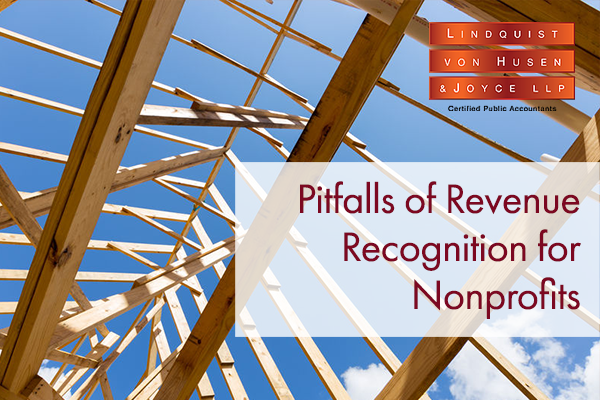
One of the challenges many not-for-profit organizations face is determining whether or not revenue falls under the category of a contribution or exchange transaction. In some cases, it’s a pretty straightforward determination, but the waters can occasionally become a bit murky.
In June 2018, the Financial Accounting Standards Board (FASB) issued the Accounting Standards Update (ASU) 2018-08, Clarifying the Scope and the Accounting Guidance for Contributions Received and Contributions Made.
Here is some clarification on the definitions of the main categories that revenue can fall into as well as additional insight as to when and how they are recognized.
- Contribution:
-
- FASB defines a contribution as “an unconditional transfer of cash or other assets to an entity or a settlement or cancellation of its liabilities in a voluntary nonreciprocal transfer by another entity acting other than as an owner.”
- Not-for-profits recognize contributions as revenue when there is verifiable documentation of a commitment to make a nonreciprocal transfer of assets, decrease of liabilities, etc.
- Exchange Transaction:
- An exchange transaction is defined by FASB as “a reciprocal transfer between two entities that results in one of the entities acquiring assets or services or satisfying liabilities by surrendering other assets or services or incurring other obligations.”
- Exchange transactions are recorded as earned, generally either when items are sold or over time as services are rendered. The ASU 2014-09 Revenue Recognition provides guidance on how and when exchange transactions should be recognized.
It is important to distinguish between contributions and exchange transactions because the revenue is recorded or recognized differently on your books.
Learn more: Is it an exchange or a contribution
Treatment of Grants Under New FASB Rules
When a donor provides a contribution that has a condition attached, FASB Accounting Standards Codification (ASC) Section 958-605-25 states that not-for-profits must wait to recognize that contribution until the conditions of that contribution are met.
The FASB ASU update has placed a renewed focus on how grants are recorded, and they provided additional clarifications to determine the nature of the grants and similar contracts with government agencies and others. Not-for-profits must be clear about any conditions that must be met to satisfy grant requirements before recognizing it as revenue.
FASB provided two questions to determine the conditional nature of a grant. Both must be answered ‘yes’ for a grant to be considered conditional and to determine the proper revenue recognition in the books.
- Does the contributor retain either a right of return to the resources provided or a right of release of promisor from its obligation to transfer resources?
- Is there a barrier the not-for-profit organization must overcome to be entitled to the resources provided?
The right of return or release must be in writing in the grant agreement or contract or in another document referenced in the grant agreement or contract.
The second question is the more difficult one to answer. FASB’s amendments provide the following criteria that are indicators of a barrier existing.
- The not-for-profit is required to achieve a measurable outcome (e.g., matching, help a specific number of beneficiaries or produce a certain number of units).
- The not-for-profit is required to accomplish the primary purpose of the agreement (e.g. scientific research findings, construct a affordable housing building). Note: This excludes trivial or administrative requirements, which are not considered barriers.
- The not-for-profit has limited discretion* over how the resources are spent (e.g., a requirement to follow specific guidelines about incurring qualifying expenses or renting units to a specific income-level of households).
One or more barriers may exist in a grant. A grant or contract may also include both conditional and unconditional contribution components.
Conditional contributions are recognized as liabilities if assets are transferred in advance of the contribution being met or not recognized at all until conditions have been met or waived by the donor. A footnote disclosure is required to provide additional insights of the conditional contributions not recognized. Unconditional contributions are recognized immediately as revenue.
FASB grant revenue recognition is a complex area. If you are unsure whether or not your grants are conditional, consult with a not-for-profit accounting advisor to determine the answers to the questions above and to help you fully understand how to record your grant.
Recording Forgivable Loans
Recording loans from local, state or the federal government on the books year-after-year can create less than favorable effects for not-for-profits. It can negatively impact financial statements and make the not-for-profit appear to be highly leveraged. Historically, a not-for-profit had an option to recognize a forgivable loan as a contribution. Under the new FASB rules, the compliance requirement stipulated in the grant agreement or contract generally is deemed a barrier.
If the right of return or release also is part of the grant agreement requirements, the forgivable loan is considered a conditional contribution. Loan proceeds received are reflected as liabilities on the books until the compliance requirements are met at the end of the compliance period. Not every forgivable loan is treated the same, so it is important to review the terms thoroughly before recording forgivable loans as a grant on your financial statements.
Determining how the recognition of contribution should be recorded can be a simple process in some cases, but as we explained above, it can also pose a few challenges for organizations. It’s important to consult with an auditor that specializes in not-for-profit accounting and advisory to make the decision that is right for you, especially when the intent or exchange associated with the contribution isn’t obvious.
Lindquist, von Husen & Joyce provides recognition of contribution and multi-year grant revenue recognitionguidance for not-for-profits and affordable housing audit and compliance requirements. Contact your engagement partner at LvHJ.
You may also be interested in this whitepaper. The Power of Financial Statement Footnote Disclosures








